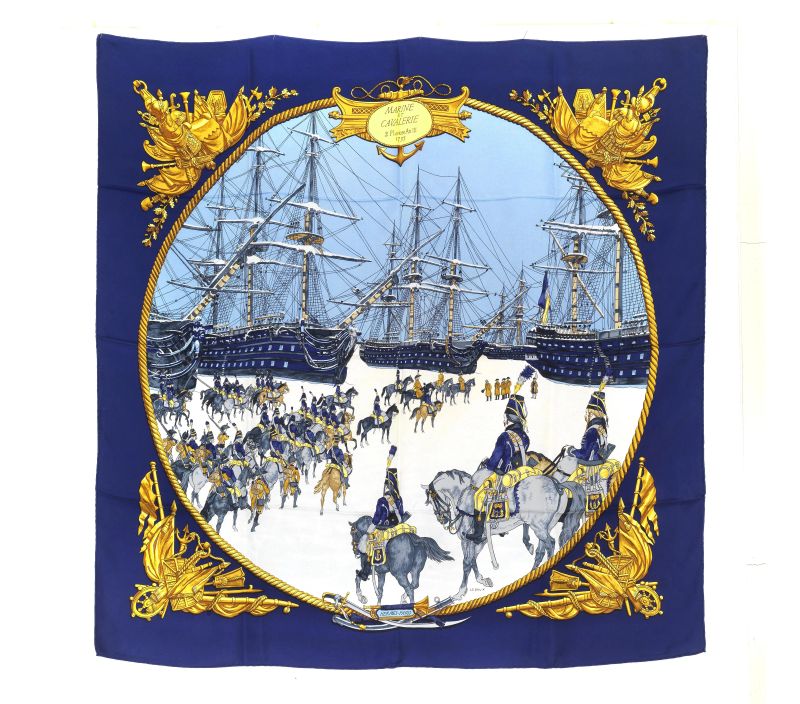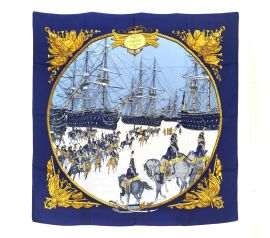HERMES CARRE FOULARD "MARINE ET CAVALERIE"
in seta, stampa "Marine et Cavalerie" disegnata dall'artista Philippe Ledoux nel 1967, raffigurante la centro la cattura della flotta olandese da parte di un reggimento di ussari francesi, Hermès Paris, firmato "Ledoux".
Dim. cm 90x90
HERMES "MARINE ET CAVALERIE" CARRE SCARF
Ispirato a un dipinto di Charles-Louis Mozin, un pittore di paesaggi e marine abbastanza noto nella prima metà del XIX secolo, il carré rappresenta un avvenimento storico singolare: la cattura della flotta olandese, bloccata dai ghiacci nel porto di Helder, vicino a Texel, da parte di un reggimento di ussari francesi nel gennaio del 1795.
A condurre l'operazione fu Jean-Charles Pichegru, generale dell'esercito rivoluzionario francese, che fece credere all'ammiraglio olandese di avere alle spalle tutto il resto dell'armata ottenendo così, senza spargimenti di sangue, la resa incondizionata di tutta la flotta. Incoraggiato da questa vittoria, il generale proseguì per Amsterdam dove entrò il 20 gennaio per occupare poi tutti i Paesi Bassi.
Pichegru divenne un eroe della Rivoluzione ma non ebbe una grande carriera poiché, nella primavera dello stesso anno, partecipò all'organizzazione di una cospirazione per il ritorno di Luigi XVIII come re di Francia: venne scoperto e deportato in Caienna, da dove fuggì rifugiandosi a Londra.
Nel 1803 tornò per guidare i realisti contro il primo Console ma, tradito da un amico, fu nuovamente arrestato e morì in prigione, non è chiaro se ucciso o suicida.
Pichegru è ricordato nelle memorie di Napoleone, che lo ebbe come insegnante di matematica all'Accademia militare di Brienne-le-Château, e che lo ricorda come un ottimo insegnante.
Inspired by a painting by Charles-Louis Mozin, a well-known landscape and marine painter in the first half of the 19th century, the carré represents a singular historical event: the capture of the Dutch fleet, blocked by ice in the port of Helder, near Texel , by a regiment of French hussars in January 1795.
To conduct the operation was Jean-Charles Pichegru, general of the French revolutionary army, who made the Dutch admiral believe that he had the rest of the army behind him, thus obtaining, without bloodshed, the unconditional surrender of the entire fleet . Encouraged by this victory, the general went on to Amsterdam where he entered on January 20 to then occupy all the Netherlands.
Pichegru became a hero of the Revolution but did not have a great career since, in the spring of the same year, he participated in the organization of a conspiracy for the return of Louis XVIII as king of France: he was discovered and deported to Cayenne, from where he fled and fled to London.
In 1803 he returned to lead the realists against the First Consul but, betrayed by a friend, he was arrested again and died in prison, it is not clear whether killed or suicidal.
Pichegru is remembered in the memoirs of Napoleon, who had him as a mathematics teacher at the Military Academy of Brienne-le-Château, and who remembers him as an excellent teacher.
Bibliografia:
"Mito e Bellezza", Catalogo a cura di Roberta Martinelli e Velia Gini Bartoli, pp 182-185, Mondadori Electa S.p.A., Verona, 2009.




